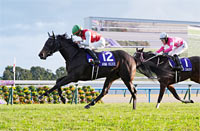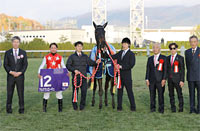Hanshin Juvenile Fillies (G1) - Data Analysis
Champion 2-year-old filly decider gives important hints for later classics
The last two winners of the Hanshin Juvenile Fillies have gone on to win G1 races held the following spring – the 2015 winner Major Emblem also won the 2016 NHK Mile Cup, while the 2016 winner Soul Stirring went on to take the next year’s Yushun Himba (Japanese Oaks). What’s more, Vodka, Tall Poppy, Buena Vista and Apapane, winners in 2006 to 2009, all won 3-year-old classic races the following spring. As well as being a key contest for the title of Best Two-Year-Old Filly in the JRA Awards, this is also an important race with links to the G1 racing season the following year. Let’s now analyze some features shared by successful runners in this race, based on results over the last 10 years.
Stronger showing if never beaten to 4th or lower
Of 30 Top 3 finishers over the last 10 years, 26 had never been beaten to “4th or lower” in a JRA race. Runners with experience of such defeats have struggled here, only managing a Top 3 ratio of 3.8%. We should not expect too much of runners with experience of finishing “4th or lower.” [Table 1]
[Table 1] Performance by experience of finishing 4th or lower in JRA races (last 10 years)
| Experience |
Performance
[1st-2nd-3rd-4th or lower] |
Win ratio |
Top 2 ratio |
Top 3 ratio |
| Yes |
0-3-1-100 |
0% |
2.9% |
3.8% |
| No |
10-7-9-50 |
13.2% |
22.4% |
34.2% |
Distance aptitude is key
Of 30 Top 3 finishers over the last 10 years, 24 had experienced wins in JRA races over distances of 1,600m or more. Horses without this experience have again fared poorly, achieving a Top 3 ratio of only 6.1%. Our focus should be on runners with experience of winning races run over the same distance as this one, or longer. [Table 2]
[Table 2] Performance by experience of winning JRA races over 1,600m+ (last 10 years)
| Experience of winning |
Performance
[1st-2nd-3rd-4th or lower] |
Win ratio |
Top 2 ratio |
Top 3 ratio |
| Yes |
10-8-6-58 |
12.2% |
22.0% |
29.3% |
| No |
0-2-4-92 |
0% |
2.0% |
6.1% |
What’s more, the six Top 3 finishers without experience of winning JRA races over distances of 1,600m or more had all experienced a Top 3 finish in “1,400m races in a one-win class or higher held at Tokyo or Kyoto Racecourse.” Runners without experience of winning races over 1,600m or more, or of a Top 3 finish in a 1,400m race of this kind, might be expected to struggle here. [Table 3]
[Table 3] Performance by Top 3 experience in “1,400m races in a one-win class or higher at Tokyo or Kyoto” by horses with no experience of winning JRA races over 1,600m+ (last 10 years)
| Experience |
Performance
[1st-2nd-3rd-4th or lower] |
Win ratio |
Top 2 ratio |
Top 3 ratio |
| Yes |
0-2-4-33 |
0% |
5.1% |
15.4% |
| No |
0-0-0-59 |
0% |
0% |
0% |
Solid showing by “Kanto (Miho) horses” and by others with good runs at Tokyo and Nakayama
Looking at aggregate performances of runners over the last 10 years in terms of their affiliation, those trained at Miho Training Center in the Kanto (eastern) region have achieved superior performances with a Top 3 ratio of 25.0%. In fact, if we limit this to the last 9 years since 2008, the aggregate performance is [4-5-5-34] and the Top 3 ratio rises to 29.2%. Though this race is held at Hanshin in the Kansai (western) region, we should definitely be on the lookout for “Kanto (Miho) horses.” [Table 4]
[Table 4] Performance by affiliation (last 10 years)
| Affiliation |
Performance
[1st-2nd-3rd-4th or lower] |
Win ratio |
Top 2 ratio |
Top 3 ratio |
| Miho |
4-5-5-42 |
7.1% |
16.1% |
25.0% |
| Ritto |
6-5-5-108 |
4.8% |
8.9% |
12.9% |
Again, of 30 Top 3 finishers over the last 10 years, 17 had “Experience of a Top 3 finish at Tokyo or Nakayama Racecourse.” These have achieved not only a Top 3 ratio of 34.0% here, but also, if limited to the last 9 years since 2008, an aggregate performance of [4-6-7-28] and a Top 3 ratio of 37.8%, or if limited to the last 3 years since 2014, an aggregate performance of [3-3-2-11] and a Top 3 ratio of 42.1%. In other words, this trend has merely been intensifying in recent years. It seems we can place our trust not only in “Kanto horses,” but also in others with solid records at Tokyo and Nakayama. [Table 5]
[Table 5] Performance by experience of a Top 3 finish at Tokyo or Nakayama (last 10 years)
| Experience |
Performance
[1st-2nd-3rd-4th or lower] |
Win ratio |
Top 2 ratio |
Top 3 ratio |
| Yes |
4-6-7-33 |
8.0% |
20.0% |
34.0% |
| No |
6-4-3-117 |
4.6% |
7.7% |
10.0% |
Check the record in graded races and the finish in the last race
Of 30 Top 3 finishers over the last 10 years, 16 had experienced a Top 3 finish in “JRA graded races over distances of 1,400m or more.” Horses answering to this description have achieved high success ratios, including a Top 3 ratio of 33.3%. We should have high expectations of runners with previous experience of contesting the top places in graded races run over 1,600m or so. [Table 6]
[Table 6] Performance by Top 3 experience in JRA graded races over 1,400m+ (last 10 years)
| Experience |
Performance
[1st-2nd-3rd-4th or lower] |
Win ratio |
Top 2 ratio |
Top 3 ratio |
| Yes |
4-7-5-32 |
8.3% |
22.9% |
33.3% |
| No |
6-3-5-118 |
4.5% |
6.8% |
10.6% |
Of horses without Top 3 experience in JRA graded races over distances of 1,400m or more, those that finished “1st, and 0.1 seconds or more ahead of the runner-up” in their previous race have amassed aggregate performances of [5-2-3-41] (Top 3 ratio 19.6%), while those without this track record have struggled, achieving only [1-1-2-77] (Top 3 ratio 4.9%). If limited to the last 9 years since 2008, their record is even worse at [0-0-2-72] (Top 3 ratio 2.7%), with no Top 2 finisher at all. Of runners with no experience of contesting the top places in graded races over distances of around 1,600m, we should have low expectations of those without a win last time out, or those with a win but only a small time difference ahead of the runner-up. [Table 7]
[Table 7] Performance of horses with no Top 3 experience in JRA graded races over 1,400m+, by finish and time difference ahead of the runner-up last time out (last 10 years)
| Finish and time difference |
Performance
[1st-2nd-3rd-4th or lower] |
Win ratio |
Top 2 ratio |
Top 3 ratio |
| 1st, 0.1 seconds or more |
5-2-3-41 |
9.8% |
13.7% |
19.6% |
| 1st, no time difference |
0-1-1-20 |
0% |
4.5% |
9.1% |
| 2nd or lower |
1-0-1-57 |
1.7% |
1.7% |
3.4% |
Seek out the winner!
No winner since 2004 has had more than three career starts
All of the last 10 winners came to this race with a career total of three or fewer starts. The last horse to win the race despite contesting more than three previous races was Yamanin Sucre in 2003 (4 starts). Other features shared by these 10 winners are that they had never been beaten to “4th or lower” in a JRA race, and all had experience of winning a “JRA race over a distance of 1,600m or more.” As such, clearing the conditions set in Tables 1 and 2 would also appear to be key. [Table 8]
[Table 8] “Total career starts,” “Lowest finish in a JRA race,” and “Highest finish in a JRA race over 1,600m+” of winning horses (last 10 years)
| Year |
Winner |
Career starts |
Lowest finish in a JRA race |
Highest finish in a JRA race
over 1,600m+ |
| 2007 |
Tall Poppy |
3 |
2nd (Kigiku Sho, etc.) |
1st (2yo maiden) |
| 2008 |
Buena Vista |
2 |
3rd (2yo newcomer) |
1st (2yo maiden) |
| 2009 |
Apapane |
3 |
3rd (2yo newcomer) |
1st (Akamatsu Sho, etc.) |
| 2010 |
Reve d’Essor |
2 |
1st (2 starts, 2 wins) |
1st (Daily Hai Nisai Stakes) |
| 2011 |
Joie de Vivre |
1 |
1st (1 start, 1 win) |
1st (2yo newcomer) |
| 2012 |
Robe Tissage |
2 |
2nd (KBS Kyoto Sho
Fantasy Stakes) |
1st (2yo newcomer) |
| 2013 |
Red Reveur |
2 |
1st (2 starts, 2 wins) |
1st (Sapporo Nisai Stakes, etc.) |
| 2014 |
Shonan Adela |
3 |
2nd (2yo newcomer) |
1st (2yo maiden) |
| 2015 |
Major Emblem |
3 |
2nd (Artemis Stakes) |
1st (Aster Sho, etc.) |
| 2016 |
Soul Stirring |
2 |
1st (2 starts, 2 wins) |
1st (Ivy Stakes, etc.) |
Note: When there is more than one race in question, the most recent one is shown.
(Masaya Ibuki) |

- Preview
- Barrier draw
- News
- Race result
- Video
- 2025 English

- 2024 English

- 2023 English

- 2022 English

- 2021 English

- 2020 English

- 2019 English

- 2018 English

- 2017 English

- 2016 English

- 2015 English

- 2014 English

- 2013 English

- 2012 English

- Photo Gallery
2025 Winner: Star Anise


2024 Winner: Arma Veloce


|


















